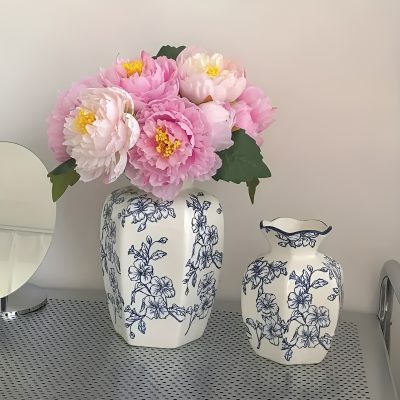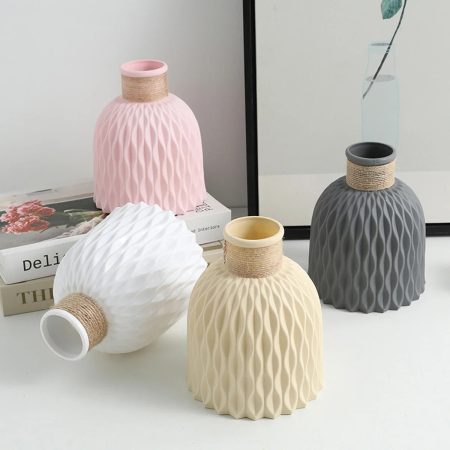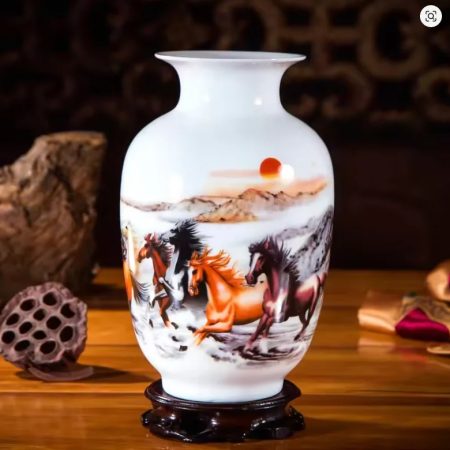Vases for Centerpieces That Elevate Your Table Décor Instantly
Why Centerpieces Matter More Than You Think
There’s an art to making a table feel inviting—and it starts right at the center. Centerpieces aren’t just decorative afterthoughts. They’re emotional anchors that guide the tone of a gathering. Think back to a dinner that truly moved you. Was it the food alone? Probably not. More likely, it was the ambiance—the glow of candlelight, the sound of laughter, and the quiet charm of a simple vase showcasing a few thoughtfully chosen stems.
A well-chosen vase can elevate a meal from functional to unforgettable. Picture this: a smoky glass cylinder holding bare branches and fairy lights at a winter gathering. Instantly, the room feels cozy, curated, and intentional. That’s the transformative power of a vase—it turns “just dinner” into a memory.
More Than Just a Container
Too often, vases are seen as mere holders for flowers, but they are storytellers in their own right. A sleek ceramic piece whispers modern elegance. A hand-painted terracotta pot sings of tradition and warmth. The style, material, and even the weight of a vase all contribute to the visual harmony of your table décor. Also see Angel Decoration for Home
I once attended a wedding where each table featured an eclectic trio of vintage vases: mercury glass, hand-blown green bottles, and classic milk glass. The floral arrangements were simple, but the vessels told a deeper story. Guests wandered from table to table, admiring them—not because they were extravagant, but because they were different. That difference made the setting unforgettable.
Elevating the Everyday
A vase doesn’t have to be grand to be impactful. Even on a quiet Tuesday, placing a bud vase with a single daisy beside your pasta can make you feel like you’re dining in a Tuscan villa. That’s the charm of a well-placed centerpiece: it brings joy, beauty, and a touch of theatre to everyday life.
Understanding Vase Styles and Materials
Glass, Ceramic, Metal: Material Makes the Mood
When selecting vases for centerpieces, material isn’t just a design choice—it’s a mood-setter. Each texture tells a unique story. Glass, for example, brings in transparency and light. It feels clean, delicate, and modern. It’s perfect when you want to highlight every curve of a tulip stem or let the water and greenery speak for themselves. Think minimalist tablescapes or chic bridal showers.
On the flip side, ceramic adds warmth and weight. Matte finishes in neutral shades instantly make a space feel grounded and artisanal. Handcrafted ceramic vases, particularly in earthy tones like ochre or sage, complement rustic, boho, or Japandi interiors beautifully. They’re tactile, soulful, and always a conversation starter.
Metal vases, such as those made from brass, copper, or pewter, inject drama. They reflect candlelight in just the right way, perfect for evening events or festive dinners. These work well when you want the centerpiece to sparkle without needing excessive decoration.
Shape and Silhouette: Design Beyond the Bloom
The shape of a vase plays just as crucial a role as its material. A tall, narrow-necked vase is ideal for long-stemmed florals like gladiolus, delphiniums, or lilies. These create vertical drama without crowding your dining line of sight. Low and wide bowls, often called compote vases, are fantastic for fuller arrangements with roses, dahlias, or hydrangeas.
Then there are asymmetric and sculptural vases—think donut-shaped, hourglass, or double-necked designs. These are bold and artistic, often needing minimal flowers to look complete. They make great solo pieces for modern tables or clustered in odd numbers for visual rhythm.
When you understand the balance between material and form, choosing a vase becomes more intuitive. It’s no longer just “what fits,” but “what tells your story” on that table.
Vase Styling for Different Occasions
From Casual Brunches to Black-Tie Dinners
Not all tables are created equal—and neither are their centerpieces. The beauty of vases lies in their versatility. For casual brunches, think breezy and unfussy. A small bud vase with a few chamomile sprigs or billy buttons in soft pastel tones can make a pancake stack feel like a garden party. Mason jars or recycled milk bottles work wonderfully here, especially when paired with natural linens and mismatched ceramics.
For more elevated affairs—such as a black-tie dinner or a milestone celebration—opt for statement pieces. A pair of tall glass vases filled with long-stemmed calla lilies adds height and elegance without obstructing eye contact. If you’re serving a multicourse dinner, a series of petite vases down the length of the table will add refinement without cluttering the surface.
Weddings, meanwhile, call for layered textures and storytelling. Cluster different vase heights together to create dimension. Mix glass with ceramic or stone for a curated look. Add trailing greenery like ivy or eucalyptus to soften the silhouette and introduce movement.
Seasonal Styling That Speaks to the Moment
Leaning into the seasons adds authenticity to your table décor. Spring calls for delicate florals like ranunculus or anemones in pastel-hued vases—blush, lavender, mint. Pair them with lighter textures like frosted glass or glazed porcelain. Summer welcomes wildflowers in rustic vessels—think terracotta jugs, bamboo vases, or even vintage watering cans.
Autumn encourages depth—burnt orange blooms, dried grasses, and amber glass vases that echo the warmth of falling leaves. For winter, embrace metallics. Bronze vases filled with white roses or fir sprigs dusted in faux snow create a cozy, luxe ambiance.
Matching vases to moments not only enhances aesthetics, but also lets your guests feel the season at the table.
Color Coordination & Floral Pairings
Creating Harmony with Vase and Flower Colors
Color coordination is where the magic often happens. You don’t need to be a trained florist to understand that some color pairings simply sing, while others fall flat. A cobalt blue vase with vibrant yellow tulips instantly adds a cheerful contrast—a classic complementary pairing from the color wheel. Similarly, white or ivory ceramic vases serve as a calm canvas for bold, saturated florals like red peonies or fuchsia ranunculus.
For a tone-on-tone look that feels upscale, pair a sage green vase with soft eucalyptus and pale cream roses. It whispers elegance without trying too hard. Monochromatic schemes are equally effective. A deep burgundy vase filled with wine-colored dahlias and blackberries creates an intensely rich, dramatic look that’s perfect for fall gatherings or moody romantic dinners.
The trick is to find balance: if your flowers are bright and busy, keep the vase understated. If your vase is colorful or intricately designed, let the florals be simple—maybe even just a few stems.
Neutral vs. Bold Vase Choices
Neutral vases are the workhorses of any centerpiece collection. They blend, support, and let other elements shine. A clear glass cylinder, a beige stoneware pot, or a soft white bud vase will never go out of style. They’re particularly helpful if you like to experiment with different blooms or change décor often.
But every now and then, a bold vase is exactly what a table needs. Imagine a tangerine-colored glass vase in the middle of a minimalist setting—it becomes a point of focus and infuses energy into the space. Or a matte black ceramic vessel—angular and moody—paired with minimalist greenery for an edgy, contemporary vibe.
Choosing between bold and neutral isn’t about playing it safe or loud; it’s about intention. What do you want your centerpiece to say?
DIY Tips and Budget-Friendly Centerpiece Ideas
Repurpose with Style: Everyday Items as Stunning Vases
You don’t need a luxury homeware store budget to create impactful centerpieces. In fact, some of the most charming vases are already sitting in your kitchen cabinets. A narrow olive oil bottle, a mismatched teacup, or an old perfume bottle can become a unique and visually intriguing vase. The trick is to think beyond the obvious.
A favorite DIY trick: collect a few glass soda bottles, remove the labels, and cluster them together with a single stem in each. It creates instant symmetry and height variation without costing more than a cold drink. Even chipped mugs can add rustic character when paired with short-stemmed wildflowers or dried lavender.
Wine bottles painted with matte chalk paint and tied with twine also add a farmhouse feel. If you prefer modern minimalism, try square condiment jars cleaned out and lined in rows with a monochrome flower choice—baby’s breath, white carnations, or even ferns.
Big Impact with Minimal Blooms
You don’t need a florist’s full bouquet to make a statement. One of the most underrated tricks in the styling world is using fewer flowers more thoughtfully. A single sunflower in a ceramic jug. Three anthuriums in a tall fluted vase. Or a sprig of rosemary and thyme in a short vintage creamer. It’s all about placement, proportion, and negative space.
Adding non-floral elements like feathers, wheat stalks, or dried citrus slices also brings texture without extra cost. These last longer and can often be reused throughout the year.
Pair your minimalist approach with intentional table linens, candles, or small scattered stones for added visual depth. Simple doesn’t mean sparse—it means smart, personal, and perfectly curated for your table.
Where to Shop & How to Care for Your Vases
Finding Unique Vases That Reflect Your Style
The hunt for the perfect vase doesn’t have to lead you to overpriced boutiques—though, if your budget allows, there’s magic in investing in a few statement pieces from artisan studios. But for the rest of us, sourcing stylish, affordable, and unique vases can be just as rewarding.
Start with local thrift stores and flea markets. These places are goldmines for character-rich vases that tell a story. You’ll often find hand-painted ceramics, retro glass, or even brass urns at a fraction of the retail price. Etsy also offers a treasure trove of handmade or vintage vases from sellers worldwide—just be sure to check seller reviews and shipping policies.
For budget-friendly but design-forward picks, check out stores like H&M Home, IKEA, or Urban Outfitters Home. These brands often rotate seasonal collections, which makes it easy to update your table décor year-round.
Want something truly one-of-a-kind? Look into local ceramicists or visit a nearby pottery studio. Supporting small artisans not only helps the community—it adds soul to your space.
Caring for Vases to Keep Them Beautiful Longer
Proper care extends the life and luster of your vases. Always rinse them immediately after use—especially if they’ve held water for multiple days. Flowers decay fast, and the bacteria can stain or fog glass and ceramic interiors. Use a bottle brush and mild soap for narrow-necked vases. For stubborn residue or water stains, mix vinegar and baking soda inside and let it sit for 10–15 minutes before scrubbing. Avoid using boiling water on delicate vintage glass—it can cause cracks.
When not in use, store vases upright and padded, especially if they’re ceramic or glass. Wrap them in fabric or bubble wrap to prevent chipping. A little care goes a long way in preserving their charm.
Frequently Asked Questions (FAQs)
1. What size vase is best for a dining table centerpiece?
Aim for a vase under 12 inches tall for most dining tables to avoid obstructing sightlines. For larger tables, use multiple smaller vases instead of one oversized piece.
2. Can I use artificial flowers in my centerpiece vase?
Yes, but opt for high-quality faux florals or dried arrangements. These require less maintenance and can look just as elegant if styled thoughtfully.
3. How do I make a simple vase look more expensive?
Paint it with matte spray paint, tie a linen ribbon around the neck, or cluster it with others in varying heights and textures to add visual richness.
4. Where can I buy budget-friendly vases online?
Check out Dreamy Design Gallery for affordable and stylish options.
5. How often should I clean my vases?
Clean them after each use to prevent bacteria buildup. For decorative-only vases, a light dusting every few weeks is enough.
📍Looking to upgrade your table décor with unique centerpiece vases?
Visit our curated vase collection at Dreamy Design Gallery for handcrafted designs, timeless styles, and free shipping on your first order.



